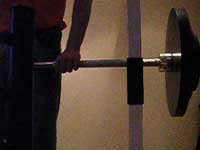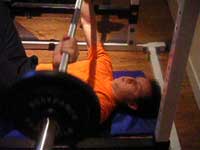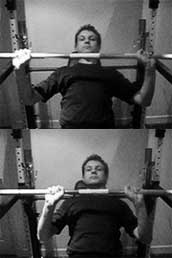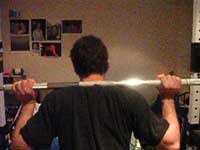 Following on from last week's DE SQ/DL session, I decided to add some heavier sets to today's high rack pulls. Much better, although I suspect I could add a little more weight without sacrificing a great deal of speed. Will have to test that theory next week.
Following on from last week's DE SQ/DL session, I decided to add some heavier sets to today's high rack pulls. Much better, although I suspect I could add a little more weight without sacrificing a great deal of speed. Will have to test that theory next week.
After the rack pulls came an exercise that's managed to elude me thus far, the Front Squat. After watching the clip of hands-free front squatting pointed to by Kris the other day, I was keen to give this movement a try. After a few sets I realised that the hands-free approach wasn't anywhere near happening (it took a while to get used to simply having the bar in front of the body) and decided to leave it to a dedicated front squatting session. Monday is the current target for that one.
As with the rack pulls, the Romanian Deadlifts were done using a sumo stance; which is slowly feeling more normal. A few more weeks and I might just switch the back squatting to the same stance.
Total time : 48 mins
 Following on from
Following on from  A glance through my workout notes for the last few weeks shows that I'm changing exercises perhaps a little too often. Whilst variation is certainly a good thing, performing the same exercises (at least the openers for each session) for a couple of consecutive weeks also has its benefits.
A glance through my workout notes for the last few weeks shows that I'm changing exercises perhaps a little too often. Whilst variation is certainly a good thing, performing the same exercises (at least the openers for each session) for a couple of consecutive weeks also has its benefits. A glance through my workout notes for the last few weeks shows that I'm changing exercises perhaps a little too often. Whilst variation is certainly a good thing, performing the same exercises (at least the openers for each session) for a couple of consecutive weeks also has its benefits.
A glance through my workout notes for the last few weeks shows that I'm changing exercises perhaps a little too often. Whilst variation is certainly a good thing, performing the same exercises (at least the openers for each session) for a couple of consecutive weeks also has its benefits.
 After noticing that
After noticing that  Over the past few days the temperature has gradually fallen, and a longer-than-usual warmup was called for. Always a fine line between being ready for action and pre-exhaustion.
Over the past few days the temperature has gradually fallen, and a longer-than-usual warmup was called for. Always a fine line between being ready for action and pre-exhaustion. Over the past few days the temperature has gradually fallen, and a longer-than-usual warmup was called for. Always a fine line between being ready for action and pre-exhaustion.
Over the past few days the temperature has gradually fallen, and a longer-than-usual warmup was called for. Always a fine line between being ready for action and pre-exhaustion.